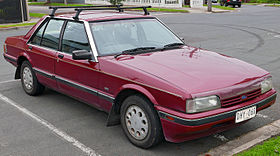Ford Falcon (XF)
| Ford XF Falcon | |
|---|---|

Ford Fairmont sedan
|
|
| Overview | |
| Manufacturer | Ford Australia |
| Also called | Ford Fairmont Nissan Ute |
| Production | October 1984 – February 1988 (sedan, wagon) October 1984 – March 1993 (utility, panel van) |
| Body and chassis | |
| Class | Full-size |
| Body style | 2-door coupé utility 2-door panel van 4-door sedan 5-door station wagon |
| Related |
Ford ZL Fairlane Ford FE LTD |
| Powertrain | |
| Engine | 3.3 L I6 4.1 L I6 (Carburetor) 4.1 L I6 (EFI) |
| Transmission | 3-speed automatic 3-speed manual 4-speed manual 5-speed manual |
| Dimensions | |
| Length | 4,775 mm (188.0 in) |
| Width | 1,860 mm (73.2 in) |
| Height | 1,367 mm (53.8 in) |
| Curb weight | 1,333 kg (2,939 lb) |
| Chronology | |
| Predecessor | XE Falcon |
| Successor |
EA Falcon (sedan, wagon) XG Falcon (utility, panel van) |
|
|
The Ford Falcon (XF) is a full-size car that was produced by Ford Australia from 1984 to 1988. It was the third and final iteration of the fourth generation of this Australian-made model and also included the Ford Fairmont (XF)—the luxury-oriented version of the Falcon. Between 1993 and 1999, this series provided the platform for the Falcon utility (XG and XH) that was sold alongside the fifth generation.
The XF sedan and wagon range was sold between October 1984 and February 1988, with the utility and panel vans running through to March 1993.
The ride and handling were described as competent, but the non-powered steering was heavy at low speeds with an overly strong castor action after performing a manoeuvre such as a U-turn. Engines were modified to run on unleaded fuel from January 1986. The XF series remains Ford's best-selling Falcon model ever built by Ford Australia with 278,101 built.
XF models were available with a choice of 3.3 or 4.1-litre engine six-cylinder engines. The 4.1-litre unit was standard on Fairmont models.
Transmissions available were four- or five-speed manual floor shift, or the much more popular three-speed automatic with the selector lever located either on the floor or the column in cars that seat six. In three-seat utilities and vans, the three-speed manual on the column was standard.
An optional "S" pack was available on some models, featuring body stripes, fog lamps, styled wheels, Falcon "S" badging, steering rack adjustment, driver's lumbar support, driver's seat tilt and footrest and sports instrument cluster.
Ford produced some limited edition value-packaged vehicles during the XF-series, including the Falcon Silver Edition sedan of 1985 to commemorate the 25th anniversary of the Ford Falcon in Australia. There was also the six-seater GL-based Falcon Family Edition sedan and wagon of 1986. These limited edition vehicles featured unique versions of two-tone "style-tone" paintwork.
1986–1988 Ford Falcon GL sedan
1987 Ford Falcon GL wagon
1985 Ford Falcon Silver Anniversary sedan
1986–1988 Ford Fairmont Ghia sedan
1990–1993 Ford Falcon utility
1988–1990 Ford Falcon utility
The Nissan Ute was a badge engineered version of the XF Falcon utility sold by Nissan in Australia from August 1988 to 1991. Nissan Utes were sold as a result of a model-sharing scheme known as the Button car plan. In an attempt to rationalise the Australian automotive industry, the Button plan induced car manufacturers to share core platforms. For this particular vehicle, XF series Ford utility vehicles were rebadged as "Nissan".
...
Wikipedia
